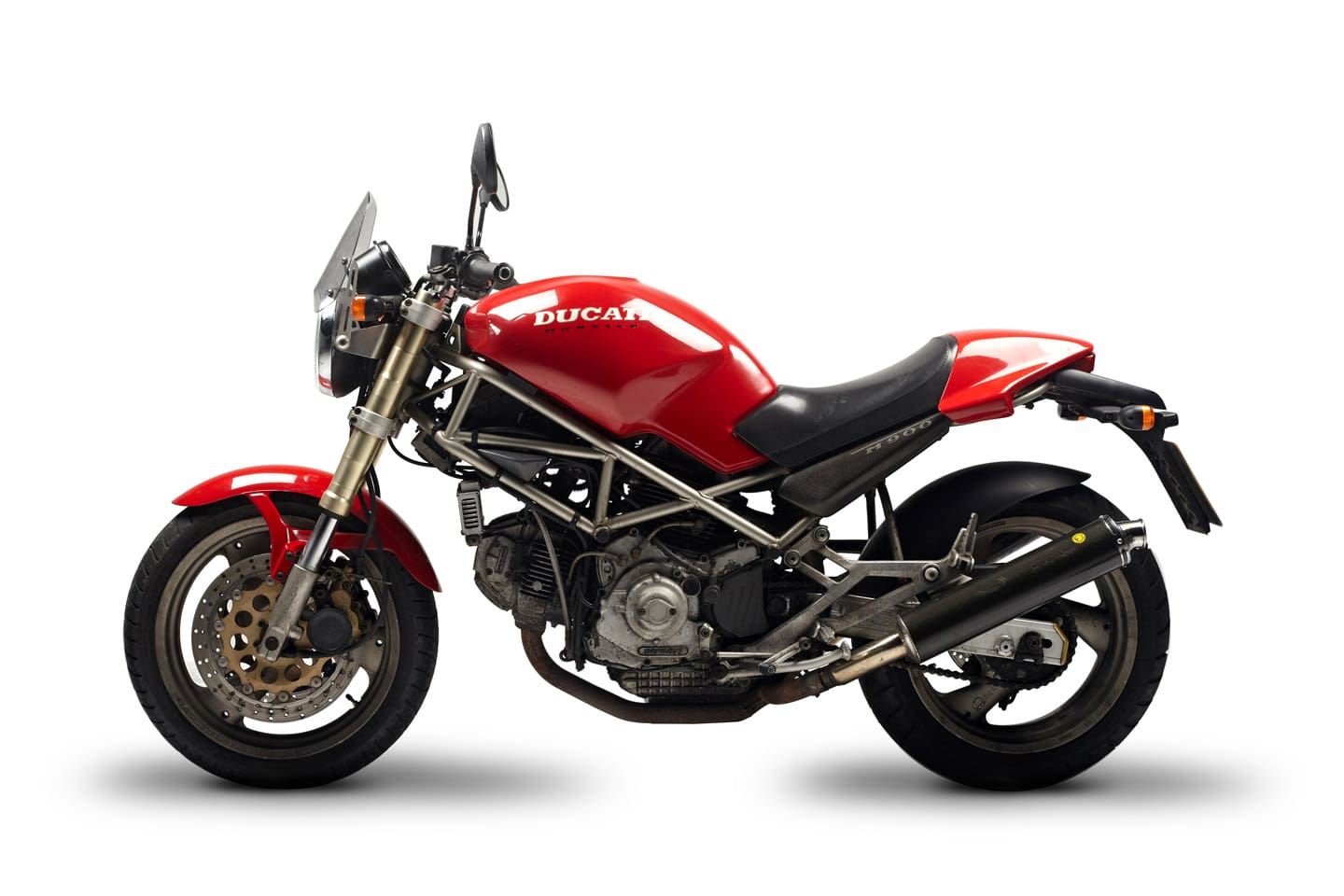The funny thing about the Ducati Monster, the best-seller that kept the Bologna factory’s doors open during a very lean period, is that Ducati purists, the Ducatisti, struggled to appreciate it. Learning to love a naked hooligan bike was a big ask to many of the rusted-on fans of the brand’s traditional fully-faired sportsbikes.
The arrival of the M900 Monster in 1994 showed the iconic Italian brand in a whole new light. The muscular-looking, naked Monster was aimed at a new audience, the edgy urban ‘rebels’ (along with wannabe urban rebels) looking for an edgy urban motorcycle. And it worked.
Rebels and wannabes bought it, as did big numbers of mainstream motorcyclists who recognised what they were getting – a versatile minimalist bike powered by the much-admired 900SS sportsbike engine (boasting Ducati’s trademark Desmo valve train) slung under a trellis-frame borrowed from the 888 superbike. The compact and light Monster package was an agile and user-friendly motorcycle thanks to its accessible low seat and the fact that it delivered lively performance without requiring riders to adopt a racer crouch. And what’s not to love about the ‘Desmo-Duc’ prestige-factor as you enjoy your Monster for daily rides, casual café-hopping or weekend scratching?
While the specifics of this review cover the traditional big-bore, air-cooled, two-valve 1994-2002 900 and 2002-06 1000 models (prior to the substantially restyled S2R models), there are Monsters to suit all tastes – all Desmo V-twin powered, with engines ranging from a humble 400cc version to the stove-hot, liquid-cooled, four-valve, 998cc Testastretta superbike engine. The 600cc middleweight in particular proved to be extremely popular in many markets with riders of both sexes.
The Monster’s minimalism extended to its equipment – no centrestand, not even a tachometer on the first model. But the suspension and brakes were well-specced to complement the engine’s performance – inverted 41mm Showa forks, Boge monoshock and four-piston Brembo calipers gripping 320mm floating front discs. The six-speed gearbox is an easy shifter, however some found the clutch action on early models to be heavy.
The visual impression that the Monster is all about the engine is reinforced when you fire it up and experience its strong V-twin power-pulses and soak up the raucous sound and feel.
On the road it’s quick off the mark for several reasons – the engine’s bulk torque, the bike’s moderate 185kg dry weight and shorter gearing than its sportsbike siblings. Power monos in first are a piece of cake for the same reasons, confirming its ‘rebel’ credentials.
It’s a lively bike and an agile, sure-footed handler, that’s at its best when you ride the huge wave of mid-range torque. It’s all about sensual pleasure and never better than when you’re leaning in behind the wide ’bars, powering out of a fast sweeper, soaking up the brutish rhythms of the big V-twin.
The modest peak power (900 – 60kW; 1000 – 63kW) is a perfect fit with the nakedbike aerodynamics. While top speed is fine (210km/h-plus), that’s not where you’ll often be on a naked M900.
The lack of wind and weather protection also limits its appeal as a tourer. In a similar vein, its pillion accommodation is really only adequate for short trips. However its 18-litre tank is good for a safe touring range of at least 250km for hardy enthusiasts.
But hey, the Monster’s not really about ultimate performance. Above all it’s a fun all-rounder, intended to make you look cool and feel good around town while popping the odd mono away from the lights when only your admiring public is looking.
A good used M900 or M1000 Monster offers an affordable opportunity for fans of the iconic Italian brand to have their own ‘Desmo’, in an attractive package that’s actually a reasonably versatile motorcycle.

PRICE GUIDE
New price
$15,995 (1994) $16,495 (2006)
Secondhand
$3900 – $8200
WHAT TO LOOK FOR
Given Ducati’s unique technicalities, an example with evidence of regular specialist servicing is the gold standard.
If you’re buying from a ‘mono-monkey’ check the condition of the vulnerable items – particularly a slipping clutch and/or worn steering-head bearings.
As always adjust your offer to cover upcoming replacements – cam-belts, chain, sprockets, tyres and brake pads, also brake rotors near minimum thickness.
The ideal prospect is a low kays example with a full service record.
BUILDING BRICKS
1953 Triumph 6T Thunderbird
Ducati’s Massimo Bordi reckoned the Monster was the modern equivalent of Marlon Brando’s Thunderbird in The Wild One movie.

1989 Ducati 900SS
The Ducati 900 Supersport provided the air-cooled Desmo engine and six-speed gearbox to power the new big-bore Monster.

1992 Ducati 888
The Ducati 888 sportsbike trellis frame provided the ideal starting point for a suitable chassis for the Monster

SERVICE HISTORY
Ducati’s belt-drive two-valve V-twin is a robust, well-designed engine.
While the unique desmodromic valve-system needs specialist maintenance, some capable DIY mechanics have mastered the required ‘Desmo’ skills.
Full services including oil, filter and valve clearance work are required at 10,000km intervals. However it’s cheap insurance on a hard-working air-cooled engine to change oil and filter every 5000km.
Cam belts should be replaced at 20,000km or every two years, whichever occurs first.
- Electronic fuel injection took over the fuelling task of the 900 Monster in 2000 overcoming some tuning issues of carburettor models.
- In 2001 the already capable brakes were upgraded with the addition of Brembo 4-piston front calipers.
- The new 1000 Monster of 2002 featured all-new cylinder heads with larger valves, revised valve angles and dual spark plugs.
- The Monster’s designer. Miguel Galluzzi, an Argentinian, penned his first motorcycle designs for Cagiva in 1989.
Words Rob Blackbourn Photography AMCN Archives











